
Amazon, the juggernaut of online marketplaces, is used by millions of customers every day. With billions of products being sold each year, there is no denying the potential sales revenue that can be generated by listing your products on Amazon even with all the competition.
So is Amazon the right place for you to be selling?
We will break a few things down to help you better understand where the best place to showcase your products may be. We will also go over the key aspects of selling on Amazon versus your personal site so that you can decide for yourself the best route to take when building your business.
In this article we will walk you through:
- Pros and Cons of Selling on Amazon vs. Personal Website
- Amazon Advertising and Selling Strategies
- Website Advertising and Selling Strategies
Pros and Cons of Selling on Amazon vs. Personal Website
With 112 million Prime subscribers just in the US, it’s no question that Amazon has a large customer base. There are more than 2.3 million sellers currently active in the marketplace, which makes it challenging to be seen. Understanding the pros and cons of navigating the platform for running a successful eCommerce business is overwhelming.
There are obviously numerous pros and cons to selling on Amazon versus selling on your own site. We have listed a few of these but take the time to understand your online strategy and how you are going to tackle selling online.
Selling on Your Own Website – Pros and Cons
Pros
- Control. The beauty of selling on your website is that you have full control over the content, design, and selling process. You are able to reduce competitor distractions. Any conversion rate studies all mention the same thing, remove distractions from the shopping experience. Selling on your site gives you control to remove distractions while Amazon only increases the amount of distractions for users.
- Brand Voice. It is all about you on your website. You have the opportunity to really showcase what makes your brand and your products so unique. Consumers are becoming more aware of the brands they purchase from and they want to buy from brands that they trust. In fact, one-third of consumers prefer to buy from brands they trust to ensure they’re not wasting their time (or their money!).
- Increased Customer Loyalty. When you purchase an item through Amazon you are quick to brag about the product you got from speedy two-day shipping, not the brand you purchased from on the marketplace. When you sell on your website, your customers will refer to your brand. Additionally, chances of repeat purchases are much higher for brands that build loyal customers, which is difficult to do selling on Amazon.
Cons
- Reduced Product Visibility Online. Amazon Marketplace attracts millions of shoppers so your reach and product visibility will be reduced drastically. While Google has a massive audience, roughly 66% of consumers start their online shopping search on Amazon. Amazon is the first touchpoint for many shoppers. If your product has a short buying cycle, consumers may not even find you if they start and end their search on Amazon.
- Staffing and Overhead. You have to staff a team of knowledgeable employees that not only understand your product but are passionate about it. This will work wonders when it comes to troubleshooting, customer service, and running your website but it also requires time and resources to train and manage employees. All of which requires overhead to keep your site and business up and running.
- Returns/Customer Support. With Amazon Prime, shoppers have come to expect free returns, two-day shipping, and the ability to contact a customer service rep 24/7. If your business is lacking on customer support resources, your customers will let you know.
Selling on Amazon – Pros and Cons
Pros
- Increase in Sales Revenue. Listing on Amazon puts your products in front of millions of shoppers. Amazon’s product cataloging system allows you to optimize and categorize your products so they are shown to consumers with the most appropriate search queries. You can get super targeted traffic to your products without wasting a ton of money advertising to irrelevant shoppers. Consumers are looking at the site with the intent to buy something.
- International Shopping Exposure. Amazon’s international exposure and brand trust allow you to bring your product offerings into new markets quick;y. You can go beyond your local reach and touch audiences that are primed and ready to purchase. Seamlessly set up and ship to over 100 other countries if eligible for Amazon Global.
- Visibility on Search Engines: If you optimize your product pages for the right keywords, you can benefit by getting your listing to show up on page one of Google. Amazon has a massive amount of authority, because of that product pages rank well for highly competitive terms. Just do a search for coconut oil for example. Amazon has 2 listings on the first page of Google.
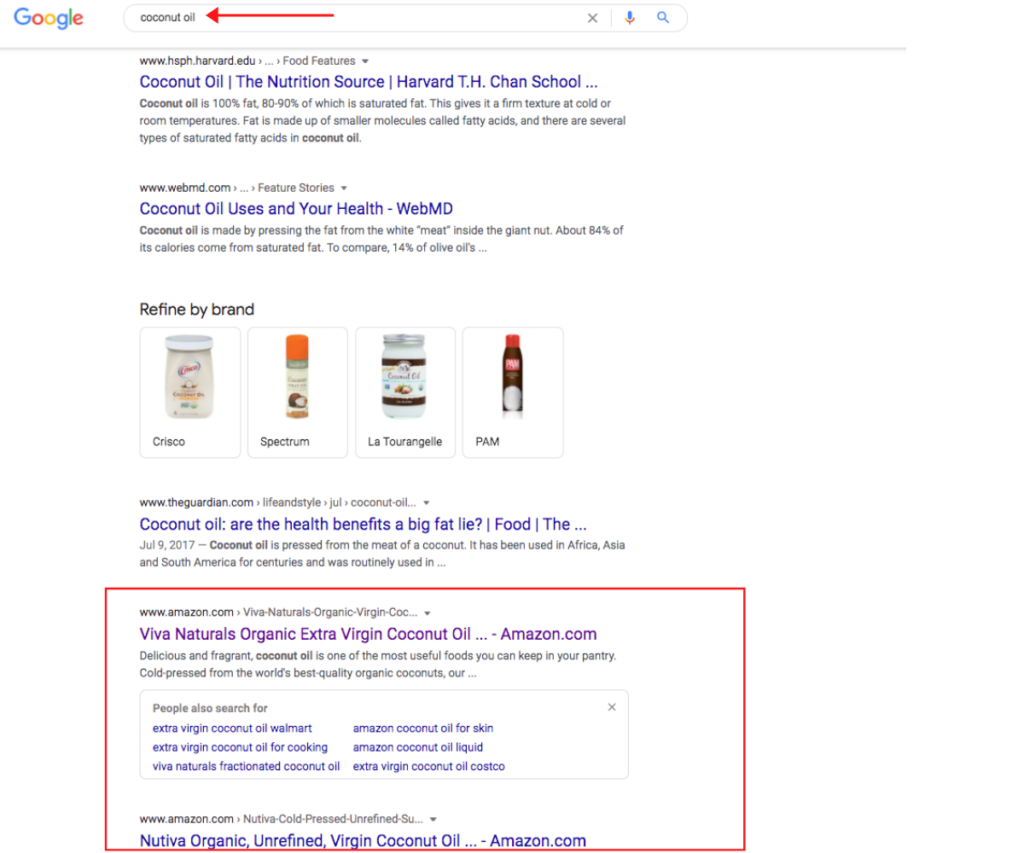
- Inventory Management. Amazon can manage your inventory, package and ship it for you so that you don’t have to worry about tracking anything. Plus, they have the infrastructure in place to support inventory management and logistics.
Cons
- High Competition. There is no denying there is a large amount of competition when selling on Amazon and it keeps growing. Over 1 million new vendors were added to Amazon in 2019 alone. Your product category likely has thousands of other sellers that are competing with your business. As mentioned above, there are more than 2.5 million sellers on the marketplace so the competition is extremely high on Amazon.
- Low Control. Amazon has specific rules that all sellers must follow. Always remember Amazon’s loyalty is to the customer not to the seller. Since Amazon has full control of your listings, they can remove content or listings as they see fit. Product descriptions, weight, and dimensions can all be removed if they flag it all a sudden. Your entire product catalog could be removed. If you sell numerous products that could take a lot of time to get back up.
- Review Limits: Amazon has limits to what you can and can’t do. They even limit the types of product reviews you can get in a given day or week. Obviously, they are trying to stop false reviews from happening, however, if you are getting legitimate reviews then this could be a negative since reviews are important to getting organic visibility on the platform.
- Expect Fees. While your sales revenue may increase from selling on Amazon, it does have a cost associated with it. Do some research on your specific Amazon fee plan before you set up your marketplace account. Keep in mind that there are two different types of selling plans on Amazon- a professional plan and an individual plan. Consider which one would work best for you.
There are numerous other reasons why selling on Amazon versus your site and vice-a-versa make sense. You should make a list of your pros and cons as you weigh the options of where to sell your product and what platforms to leverage for your online business.
Once you have made your list of the pros and cons, we suggest diving into what advertising options you have to work with on Amazon versus your own site.
Advertising Options and Selling Tips for Amazon
Amazon’s audience is undeniably the largest selling point for businesses to open a shop with the online marketplace. Listing your products on Amazon opens the door to a huge pool of primed customers that are already in the active research phase of the sales funnel.
So how do you succeed in this competitive landscape? We will break down the advertising options and offer a few recommendations to give you a leg up on the competition.
Organic Reach on Amazon
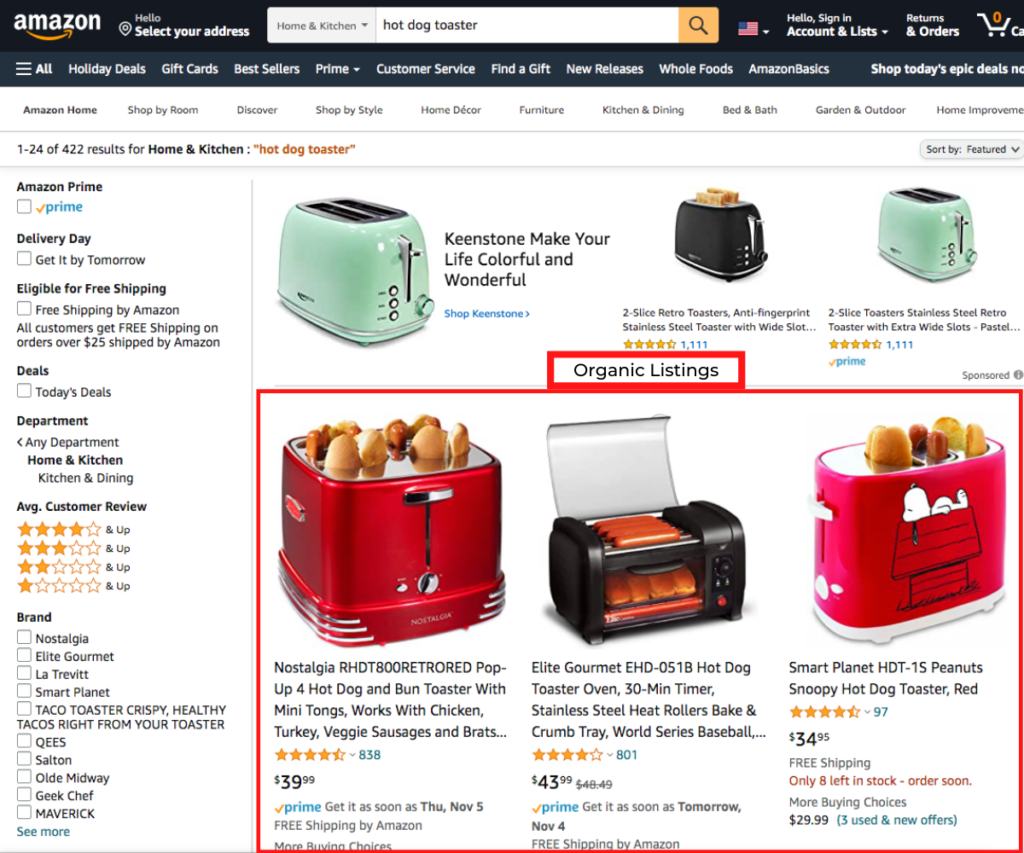
Obviously, the best advertising is free. You need to be optimizing your listings for organic search on Amazon. In order to optimize your product you need to focus on these areas:
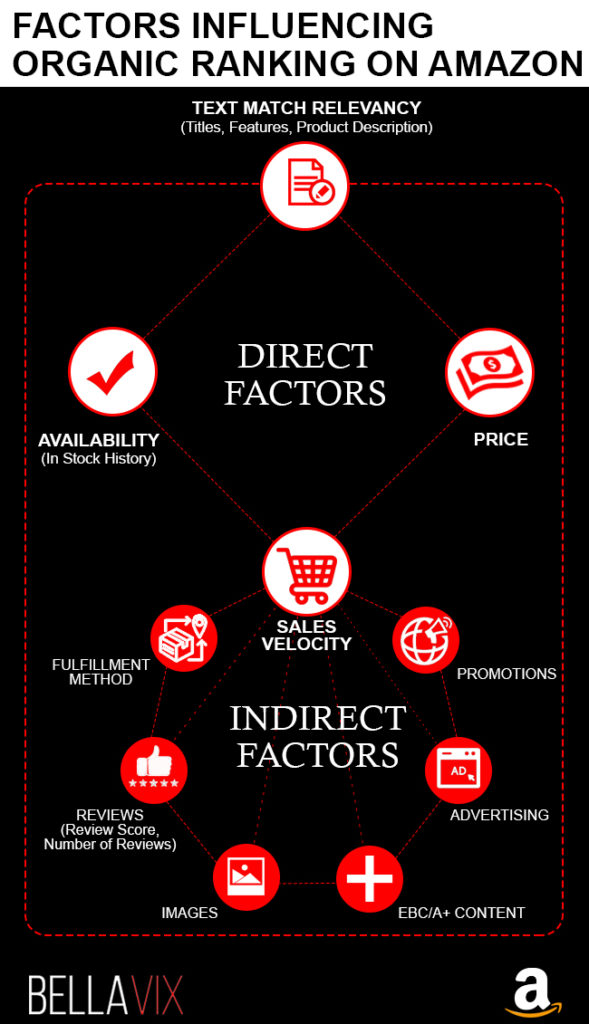
Key Takeaway: Ongoing sales is a large factor for organic rankings. Because of that, you may need to rely on ads to generate the sales needed to gain initial traction with organic reach on Amazon.
One of the most important things to consider when optimizing your product content and images, as well as gathering reviews, is that this will slowly help you to rely less on Amazon marketing over time.
It’s important to keep in mind that the Amazon search algorithm is extremely complex. There are so many things that contribute to your product rankings in an Amazon search. For example, Amazon has placed a high priority on reviews to help your rankings. In order to play Amazon’s game, many sellers have put together strategies centered on how to gather more product reviews.
Amazon advertising options.
We won’t get into all the details of how to optimize your ads on Amazon. Note that there are 4 fundamental ways to advertise on Amazon.
- Sponsored Brand Ads: Formerly known as Headline Search Ads, this specific ad program is available to individuals on Seller Central who’ve registered their brand with the Brand Registry program, as well as those on the Vendor Central platform. The Sponsored Brands program allows you to have a banner ad at both the top and the bottom of the search results page.
- Sponsored Product Ads: You’ll find that this ad type is the most popular on Amazon. Amazon has also been working on releasing other targeting options, such as product and interest targeting.
- Product Display Ads: While these ads haven’t had the same kind of popularity as sponsored products or sponsored brand ads, you’ll find that product display ads can be pretty effective in specific marketplaces. Do some research and see if it would work for your niche.
- Amazon Demand-Side Platform Ads: This ad type is specific to bigger brands that are looking for a way to generate more awareness. This platform gives you the ability to reach amazon audiences through Amazon’s Demand-side Platform (DSP).
Since Amazon offers a number of ways to advertise, sellers need to stay on top of any changes that happen in order to remain compliant and avoid getting shut down. If you sell on Amazon, you are at the mercy of Amazon, and getting your account shut down is something that can and does happen. Outside of advertising, there are some things you can do to gain some advantage on the competition and help you be successful.
Tip 1: Product Price Strategy
Our number one tip is to price your product 1.5%- 2% above the lowest seller’s bid. Pricing at this level above your competition will allow your product to remain relevant and appropriately priced regardless of competitors that continue to change prices in the pursuit of being the lowest price on the market.
In order to ensure that your products stay on page one, it’s important that you take your competition into account. It’s easy to look into- just search your top keywords, your top three will do, and look at what the pricing is on the search results for page one.
Consider whether or not your prices are within the range of prices found on the first page. For example, if I search boy toddler boy sweater 18-24 months, I can see that the prices range from$15-$25.
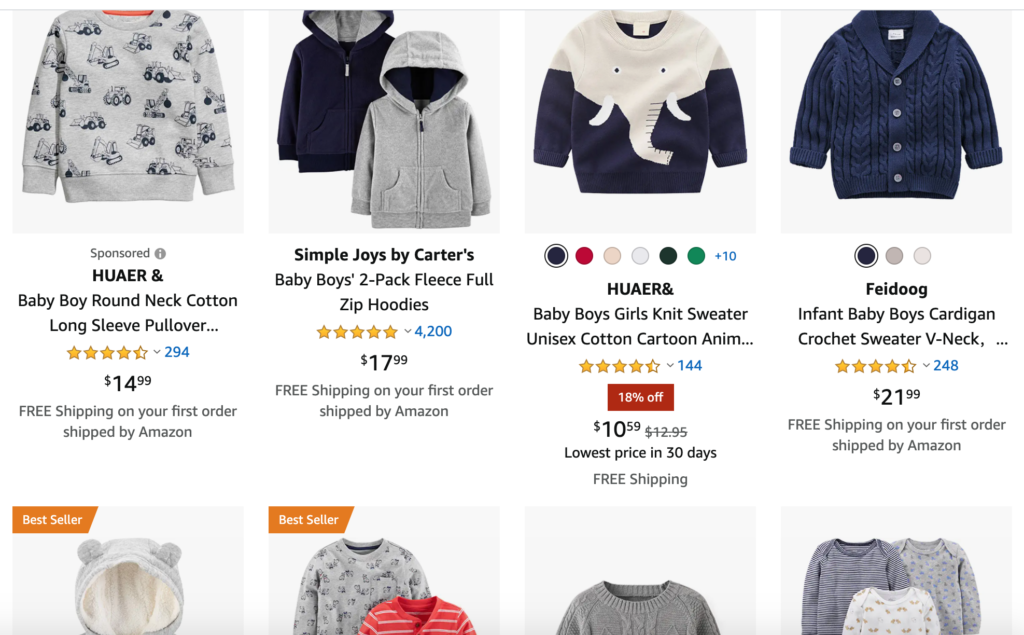
Keep in mind that you don’t necessarily have to price your items at the bottom of the range. Price things within the range, or as close to the top of the range as possible. Keep in mind that one part of the algorithm on Amazon is order volume. So if your pricing is within the range found on the first page, you’re likely to have a high volume of purchases, which will help you to stay on the first page.
Tip 2: Product Assortment Strategy
Brands that have worked to incorporate their full catalog of products on Amazon may want to reconsider their selling strategy. Amazon encourages brands to focus on item profitability and to reduce products that have little value. With competition ever increasing within the marketplace, this calls on brands to be more active in managing SKUs to maintain brand visibility.
The reality of selling on Amazon is that it is hard to be profitable when you are selling a large number of products at a low selling point.
Understanding your item profitability is vital to finding success on Amazon. Finding the right balance when it comes to price could be the thing to help your customers make the purchase. So how do you make a profitable product assortment strategy? Start looking at your brand’s highest value SKUs from a margin or brand equity standpoint. Focus on the group of products that attract organic visibility as well as paid search traffic, and make showcasing these attractive products your priority.
Weighing the Alternatives to Selling Outside of Amazon
Since Amazon is a massive player in the eCommerce space, it can be a great option for running a successful business online. However, as discussed, you are at the mercy of Amazon. It’s like building a house on rented land so you should also consider when it makes sense to leverage your own website. Note that running your own site has its challenges and we’ll discuss some of these challenges below.
Website Advertising and Selling Options
We’ll break down some alternatives that business owners can consider when they are looking to reach more online shoppers through their own website. After all, 48% say they start their product search on search engines, which makes it the second-largest starting point when shopping online.
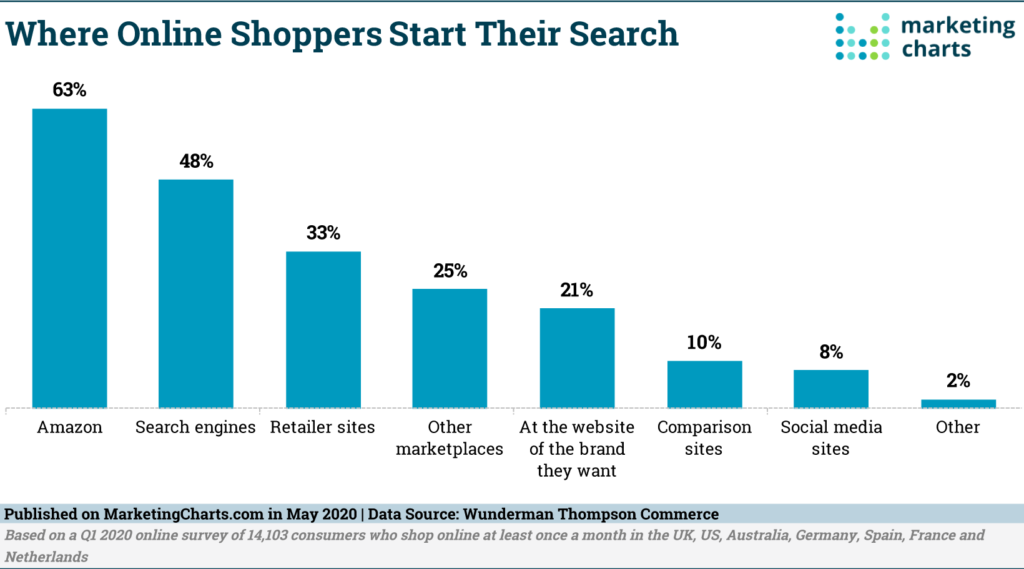
Image Source: Marketing Charts
As mentioned above, the biggest advantage of running your own site is that you own the customer and the site. Additionally, If you are looking for ways to diversify or move away from Amazon (maybe the marketplace is too overwhelming for you to manage at this time) a good option could be running your own site. We’ll walk you through some of the advertising options and ways to gain traction through your own site.
Organic Reach on Search Engines like Google
Similar to optimizing your listing on Amazon, Google uses an algorithm to decide which products should be displayed on page one of search results. By leveraging search engine optimization (SEO), you can generate organic search traffic to your site.
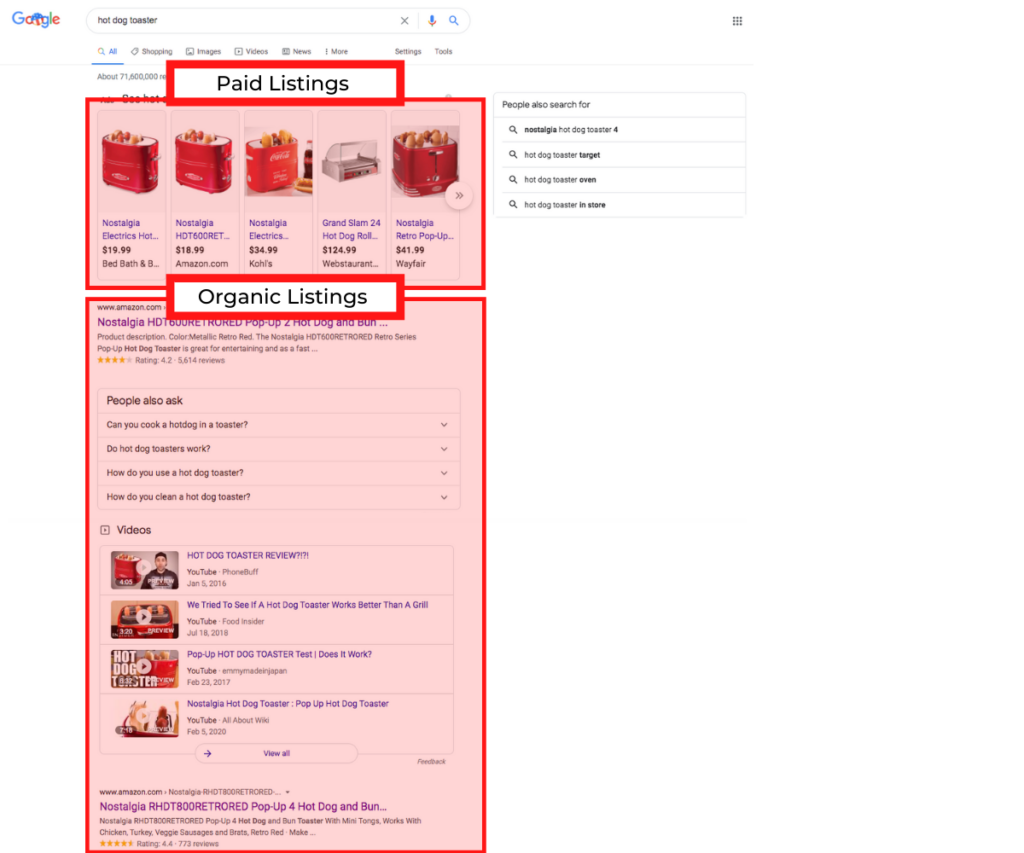
Fortunately, Google looks at similar pieces of information when ranking sites in search results. You may have noticed from the screenshot above that the first two listings on Google organic listings (minus the People ask box and Videos) are both products sold on Amazon. Google ranks Amazon really well for numerous searches. This is what Google looks for:
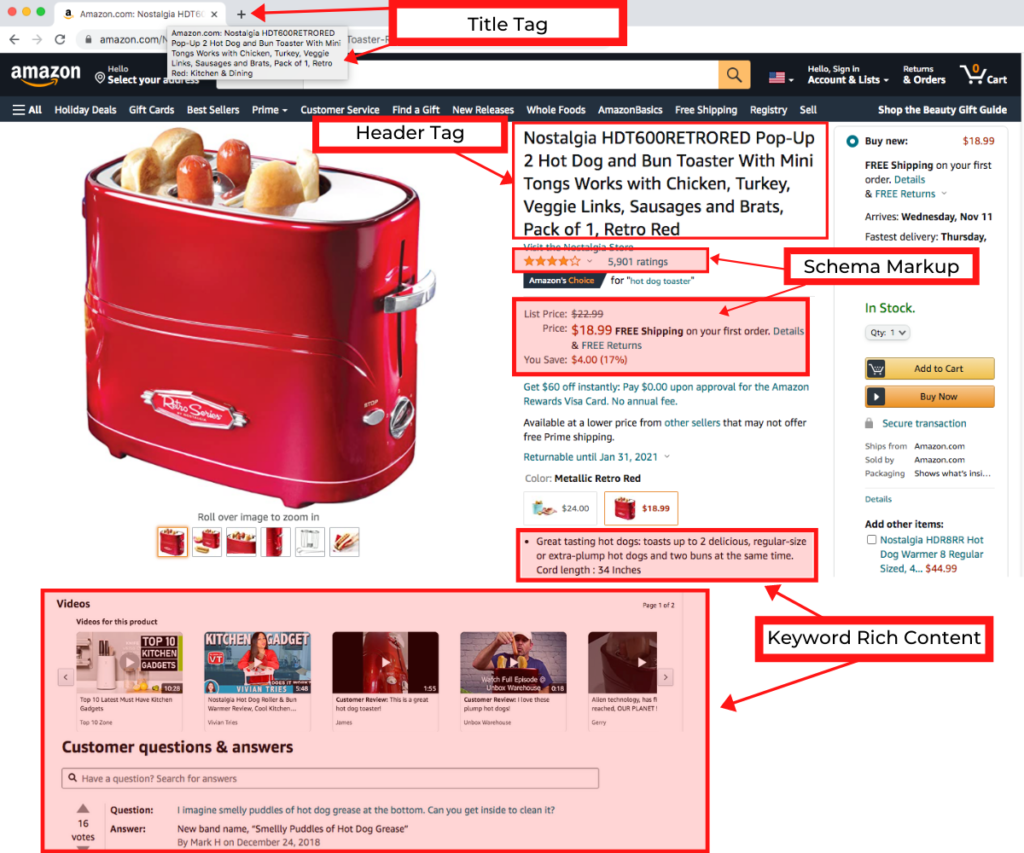
Here is a quick look into what some of the major ranking factors are with Google’s algorithm. Some of the most important things to consider for SEO in 2020 are good links back to your site and high-quality content in line with Google’s guidelines.
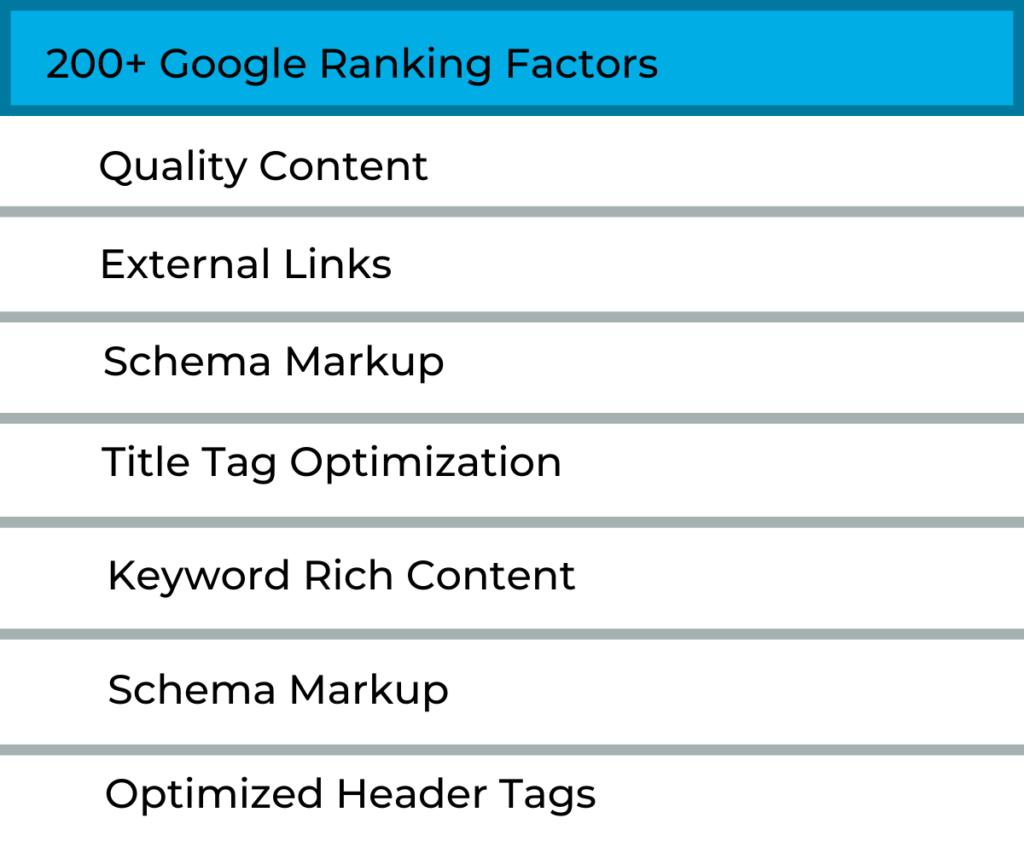
Regardless of where you sell online, your site or on Amazon, you have to generate quality images, content, links and create a great experience for your customers wherever they shop your products if you are going to compete in organic search.
Pro Tip: If you have established a strong Amazon business and you are looking to leverage your own site now, a good place to start is to optimize your Amazon product pages for Google search. Use the things you learn from optimizing your Amazon product pages and start building up your organic visibility on your site. Note, if you launch a brand new website, it will take some time to build up your organic traffic. You will need to put some resources into SEO to build up visibility.
For a complete guide on how to use SEO for an eCommerce business, our partners at STRYDE have put together this SEO guide for eCommerce sites. See it here.
Website advertising options
We won’t get into all the details of how to leverage all of these options for building an online strategy for your website but give you insight into what options are available to you as you think about growing your business. Here are the different traction channels you can use:
- Publicity/PR: Ensuring that you’re properly managing your communication between your business and the public is an incredible way to influence consumer behavior. Get more details on how to use PR in 2020 here.
- Search Ads: Search ads are a great way to reach a wider audience with your products and services. Google just made a massive change to the way they group ads together that could change the way you look at search ads.
- YouTube/ Video Ads: This has grown substantially over the years and is massive now.
- Shopping Ads: Google Shopping is the Amazon alternative we would recommend the most. Google Shopping is a subset of the Google Search network that exclusively displays products based on a customer’s search query. Approximately 100 million US consumers consult Google Shopping ads during their buying process.
- Social Media Networks: Social media is the place to establish a relationship of trust with your client base. We’ve found that the most effective thing to do is take advantage of organic social posting, not necessarily running ads.
- Paid Social Ads: The most effective places to run paid social ads are on Instagram, Facebook, and Pinterest. Tik Tok has exploded recently with their ad options, and many businesses are taking advantage of the trending social media platform.
- Email marketing: Email marketing is easy to implement and gives you the ability to reach an incredibly wide audience. Deliver targeted messages and help guide people to make purchases.
- Viral marketing: Have a lot of followers? Viral marketing is where information is distributed by others sharing it, and is a great option if you have content that you want to share with a wide audience. When creating a viral marketing strategy, be sure to create your content in a way that makes it easily shareable.
- Affiliate marketing: Get more visitors to your site with a little exposure. Affiliate marketing is a great way to have outside sources to recommend your brand and product.
- Influencer Marketing: Similar to affiliate marketing, influencer marketing is more focused on brand exposure than site visitors. Some major adjustments have been made this year with influencer marketing, so make sure you’re up to speed before creating your strategy!
- Content Marketing: Creating a place where you can share guidance and content around your brand, services, and general topics that pertain to your audience, is always a good idea. If you aren’t sure where to start looking at your competitors to see what they have done for FAQ, blog, and website copy. This will help you create a content marketing strategy that works by generating content that answers your customers’ most asked questions.
With Amazon, you are limited with what types of advertising you can do on the platform. When marketing your site, there are numerous options that can drive potential growth. The challenge becomes knowing which ones to use.
You’ll never use all these traction channels at a single time—you shouldn’t even try to. Your business should strive to focus on 2-3 traction channels at once and then run tests to see which one sticks and is the most effective solution for driving sales.
But through a specialized process, you can figure out which channels will get your business the most traction.
The biggest thing you can do when evaluating each option above is to do two things:
- Define what traction means to your business.
- Set a specific goal.
How do you do this? You take your business through five steps.
The Framework for Finding Your Traction Channel
To find your optimum traction channel, adopt what some have deemed as the bullseye mindset. The bullseye metaphor means you’re looking for that one traction channel that’s going to unlock your next customer growth stage, i.e. will give you the best shot at hitting the bullseye.
1. Brainstorm
Your objective here is to come up with at least one good strategy for each traction channel. Most people approach each channel with some type of bias that makes them think they don’t need to think of any ideas for a certain channel because it probably won’t work. This step is meant to help you nix those biases.
Before brainstorming, do some industry research. Find out what’s worked and what hasn’t worked for others in your industry. Find out how companies have gotten more customers and how companies wasted their marketing budgets. Look online and ask other eCommerce businesses you have a good working relationship with.
2. Rank
This step is where you organize your brainstorming efforts; where you do some critical thinking about each channel.
To do this, divide your traction channels into three groups by asking the following questions:
- Which channels seem the most promising right now?
- Which ones seem like they could possibly work?
- Which ones are long shots?
3. Prioritize
After dividing each channel into one of those three groups, look at only the ones you put into the most promising group. Out of that group, select your top two or three most promising channels. This is what’s referred to as your inner circle.
For the next step, you want more than one channel, but you don’t want too many. Too many channels will waste your time and efforts, and you’ll lack focus. Two or three is a good number.
4. Test
Testing your two or three prioritized traction channels tells you which channel in your inner circle you should really focus on. But don’t go overboard with your testing. Stick to smaller-scale efforts, like running five Facebook ads rather than 50, and only spend a few hundred dollars per channel.
Base your cheap tests on the following questions:
- What’s it going to cost us to get new customers through this channel?
- How many customers are actually available through this channel?
- Are these customers the ones we want at this time?
Your goal isn’t to get a ton of traction during this phase. You’re just trying to see if these test channels will work for your company and focusing on how to optimize growth with each.
If you want to try content marketing, hire a content marketing agency. Have them create a blog post or two a week for you, promote those content pieces, and then evaluate how those topics, content types, and promotional efforts worked. With SEO, depending on the industry, it’s usually a four to an eight-month period before you see some good results. But in those first few months of testing, you should be able to see steady growth, like is shown in the graph below.
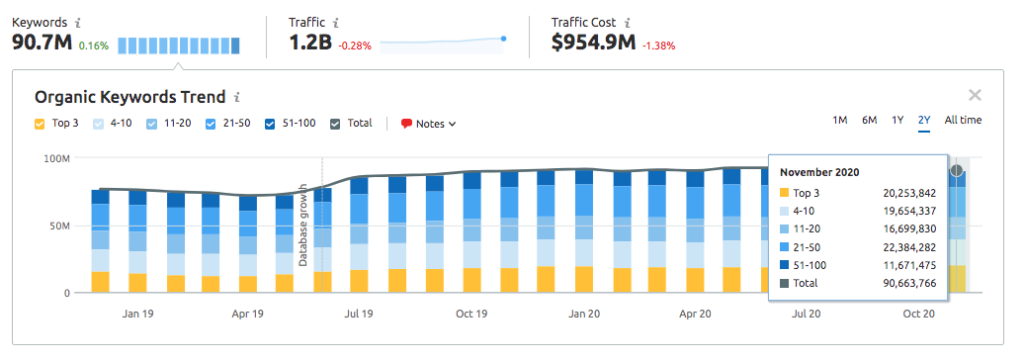
In most cases, testing involves mainly paid traction channels. And according to Neil Patel, when testing paid channels, you should increase your spend until you break even, but you never want to be more than 5-10% in the red. With organic channels, he says don’t plan on seeing a return on investment for at least six months.
5. Focus on What Works
Testing should give you one main traction channel to focus your efforts on. Once you have that channel, it’s time to get to work, doing everything you can to get all the traction you can out of that channel. This means you’ll have to continually experiment until you figure out how to optimize growth via that channel. Once you find out what works—do more of it.
One of the great things about this process is that it’s a repeatable process. So after you’ve selected a traction channel and when you’ve finally maxed out your efforts on that one channel, you can go back through steps one through four to find another promising channel.
Examples of Business That do Both
Knowing consumers use both Google and Amazon, you can target them at the same time. Use this knowledge to your advantage to reach a wider audience and generate more revenue. If you’re wanting to incorporate both Google and Amazon into your strategy, take some time to consider a few things. How will targeting change from platform to platform? How can you use both platforms without leaning too heavily on one or the other? Take a look at some examples of companies that have found a healthy balance between Google and Amazon.
Goal Zero
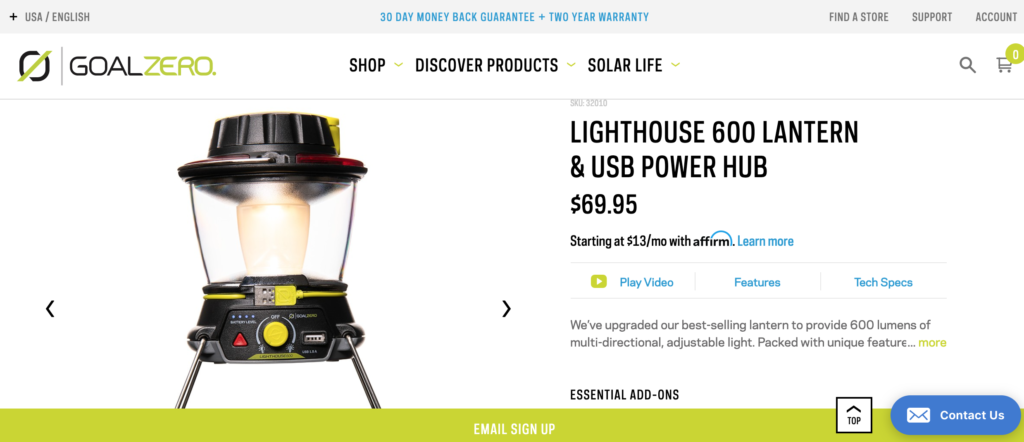
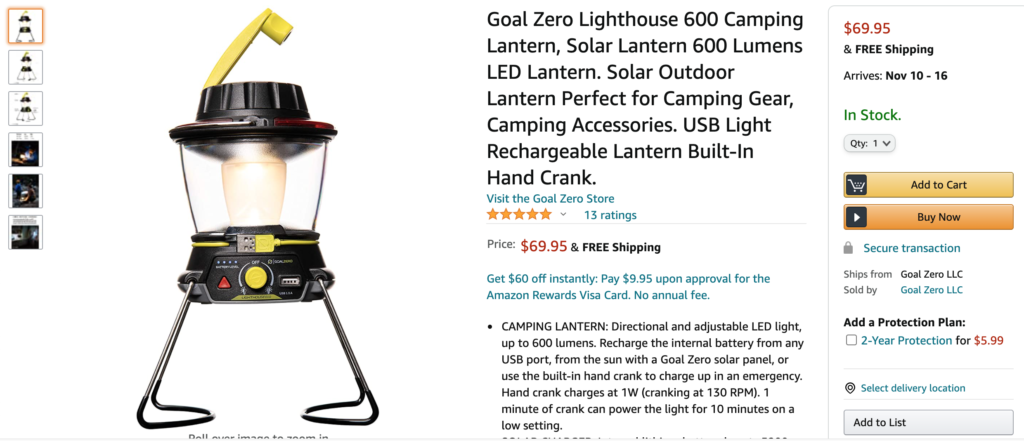
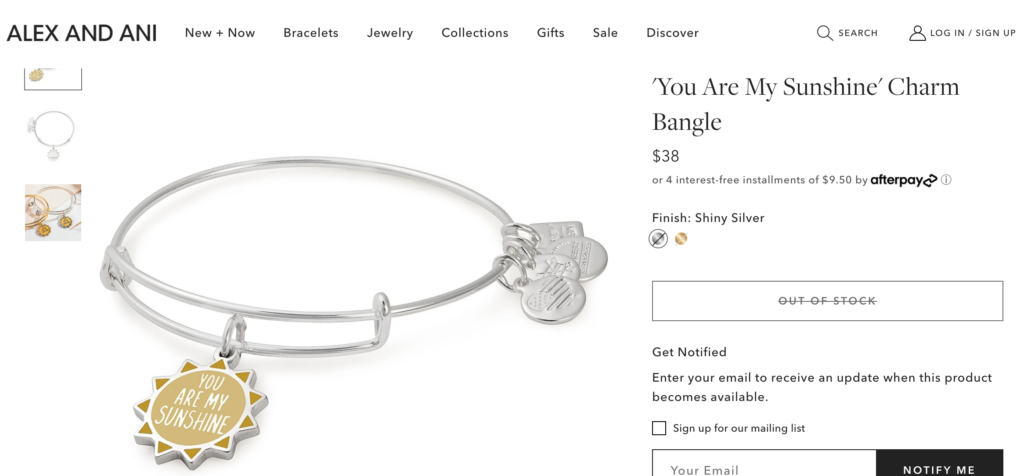
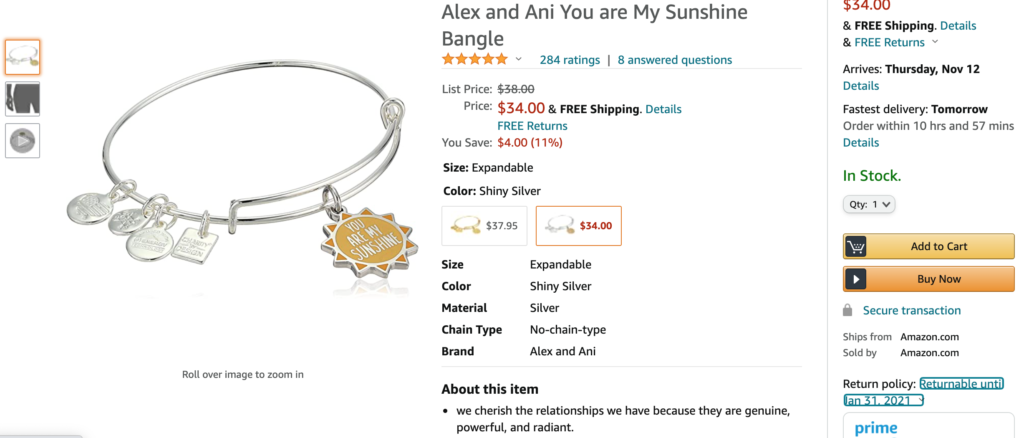
Understand Your Alternatives
Regardless of your company size and industry, there are very clear reasons to use Amazon over building your own site. The same is true of running your own site versus leveraging Amazon.
Researching your alternatives can present new lucrative opportunities for your organization. Just make sure you consider all of the options as you weigh the decision to know which is right for your business. Both options have pros and cons and will require time and resources to run an effective online business.
If you have additional questions or want us to help you on your Amazon journey, don’t hesitate to contact the BellaVix Team.
Keep up with the latest Amazon and Walmart news updates and subscribe to our BellaVix newsletter 👇👇👇

